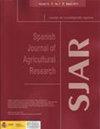基于应用区的土壤化学属性多元空间样本约简
IF 0.8
4区 农林科学
Q3 AGRICULTURE, MULTIDISCIPLINARY
引用次数: 0
摘要
研究目的:在精准农业中,农业区应用区的定义包括利用土壤化学属性将该区域划分为具有相似特征的分区。为此,聚类方法的使用是常见的。因此,AZ组成了一个数据库,可用于针对未来的土壤采样,从而寻求可能的样本减少。本文的目的是评估通过空间多元聚类生成的应用区域中包含的样本配置的获取,并减少样本量。本工作中提出的采样协议评估了用于创建AZ的五种聚类方法(C-means、Fanny、K-means、Mcquity和Ward),并通过这些AZ,获得具有50%和75%初始采样点的简化样本配置。研究区域:商业农业区,巴西卡斯卡维尔。材料和方法:使用商业农业区的土壤化学属性数据,参考三个大豆收获年份(2013-2014年、2014-2015年和2015-2016年)。聚类方法考虑了一个相异矩阵,该矩阵聚合了关于样本元素之间的欧几里得距离和属性的空间依赖结构的信息。主要结果:结果表明,在上述收获年份,考虑K均值法,将农业区划分为两个或三个AZ。将所有减少的样品配置与初始样品配置进行比较,可以观察到按比例减少25%的样品配置是获得减少样品配置的最有效的。研究亮点:使用AZ的采样方案表明,减少样本量是可能的。本文章由计算机程序翻译,如有差异,请以英文原文为准。
Multivariate spatial sample reduction of soil chemical attributes by means of application zones
Aim of study: In precision agriculture, the definition of Application Zones (AZs) in agricultural areas consists in delimiting the area in subareas with similar characteristics, using soil chemical attributes. To such end, the use of clustering methods is common. Therefore, the AZs make up a database that can be used to target future soil sampling, thus seeking a possible sample reduction. The objective of this paper is to assess the acquisition of sample configurations, with reduced sample size, contained in application zones generated by spatial multivariate clustering. The sampling protocol proposed in this work evaluated five clustering methods (C-means, Fanny, K-means, Mcquitty, and Ward) for the creation of AZs, and, through these AZs, to obtain reduced sample configurations with 50% and 75% of the initial sampling points.
Area of study: Commercial agricultural area, Cascavel, Brazil.
Material and methods: Data of the soil chemical attributes from a commercial agricultural area were used, referring to three soybean harvest years (2013-2014; 2014-2015; and 2015-2016). The clustering methods considered a dissimilarity matrix that aggregates the information about the Euclidean distance between the sample elements and the spatial dependence structure of the attributes.
Main results: The results indicated division of the agricultural area into two or three AZs for the aforementioned harvest years, considering the K-means method. Comparing all the reduced sample configurations with the initial one, it was observed that the one proportionally reduced by 25% was the most effective to obtain a reduced sample configuration.
Research highlights: The sampling protocol using AZs showed that it is possible to reduce the sample size.
求助全文
通过发布文献求助,成功后即可免费获取论文全文。
去求助
来源期刊

Spanish Journal of Agricultural Research
农林科学-农业综合
CiteScore
2.00
自引率
0.00%
发文量
60
审稿时长
6 months
期刊介绍:
The Spanish Journal of Agricultural Research (SJAR) is a quarterly international journal that accepts research articles, reviews and short communications of content related to agriculture. Research articles and short communications must report original work not previously published in any language and not under consideration for publication elsewhere.
The main aim of SJAR is to publish papers that report research findings on the following topics: agricultural economics; agricultural engineering; agricultural environment and ecology; animal breeding, genetics and reproduction; animal health and welfare; animal production; plant breeding, genetics and genetic resources; plant physiology; plant production (field and horticultural crops); plant protection; soil science; and water management.
 求助内容:
求助内容: 应助结果提醒方式:
应助结果提醒方式:


